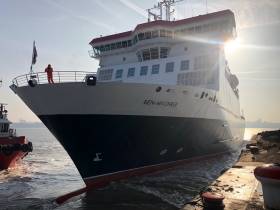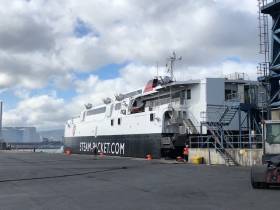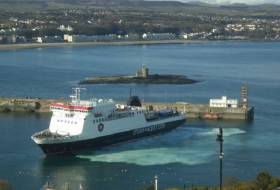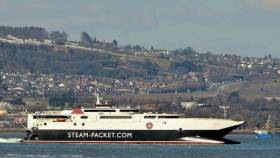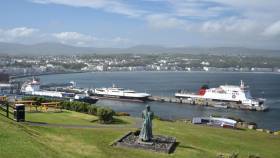Displaying items by tag: IOM Steam Packet
Isle of Man: Why Steam-Packet May Have to Divulge More Information to the Public
IOMToday writes that arm’s-length Manx government-owned ferry operations such as the Isle of Man Steam Packet could become subject to Freedom of Information laws.
Minister for Policy and Reform Chris Thomas says that transparency when public money is involved is important, but must be balanced against commercial confidentiality.
The issue of arm’s-length companies and FoI requests was highlighted when the Positive Action Group submitted a request in relation to the Steam Packet which was rejected.
The PAG asked the government’s Department of Infrastructure for ’figures for the carbon emissions of the Steam Packet fleet (for both the Manannan and the Ben-my-Chree individually) per kilometre, per mile or per journey’.
However, this was rejected as the Department of Infrastructure does not hold that information.
The DoI said in its response: ’You may already be aware that the Isle of Man Steam Packet Company is not subject to Freedom of Information, although they may be open to a dialogue on the subject if you approach them direct.’
In response to this, Mr Thomas told the Isle of Man Examiner that he personally thinks that FoI might need to be ’tailored for arm’s-length operations, in several variants for each of the types of public bodies that currently exist or might come to exist’.
The Manx government bought the Steam Packet last year for £124 million and to read more on the FoI related story click here.
Manx Ferry Returns to Scheduled Services
#ferries - The ferry Ben-My-Chree operated by the Isle of Man Steam Packet has been confirmed by the company of its return to Manx waters yesterday.
Manx Radio reports the ferry's arrival (in Douglas) follows what the operator called "successful regulatory overhaul" at Cammell Laird in Birkenhead.
In a post on social media, staff said they are "pleased to welcome her back" and "look forward to her returning to scheduled services" tomorrow (Thursday).
To see details on sailings in full, click here.
#ferries - The Isle of Man Steam Packet Company's main ferry, the ropax Ben-my-Chree arrived on Merseyside today to undergo an annual regulatory overhaul.
The work on the 12,000 gross tonnage vehicle ferry with capacity for 630 passengers is to take place at Cammell Laird, the shiprepairer and shipbuilder located in Birkenhead.
The ferry entered the dry-dock at the marine engineering facility on the Wirral Peninsula for one week and is scheduled to return to service on Thursday 2nd May.
In the meantime fast craft Manannan will operate the 'Ben's passenger services on the Douglas-Heysham/Liverpool routes during this period, as per the timetable published last autumn. The MV Arrow, which the Steam Packet Company currently has on charter, will provide freight services.
During the overhaul, Manannan will depart Douglas for Heysham at 08:00 and for Liverpool at 15:30 each day, with the return sailings departing Heysham at 12:00 and Liverpool at 19:15.
A replacement coach service will be provided at Heysham to transfer foot passengers to and from Lancaster railway station.
#ferrries - The Manx Parliament is to receive proposals ahead of the summer recess.
The future finances of the Isle of Man Steam Packet Company reports Manx Radio are expected to be considered by the parliament (Tynwald) ahead of the summer recess.
Treasury Minister Alfred Cannan confirmed at this week's sitting of the House of Keys that the structure of the sea services operator's finances is currently undergoing a review.
Following a question from Ramsey MHK Lawrie Hooper, Mr Cannan revealed the proposals should be on the July order paper once the review has been completed.
The Manx Government purchased the company last year and recently approved the Heads of Terms on a new sea services agreement.
See previous story on a political party's call for public to buy shares in the nationalised island ferry operator.
Isle of Man Steam Packet Consultation Results to be Published
#ferries - The Isle of Man infrastructure minister reports Manx Radio, has pledged to make the findings of the Steam Packet consultation available to the public - in full.
Ray Harmer recently appeared on the radio station's Perspective programme to discuss government's acquisition of the company, which he says has been ongoing since 2016.
Douglas East MHK Chris Robertshaw has been critical of Treasury and the Department of Infrastructure throughout the process, arguing there's been a lack of transparency.
Mr Harmer says full results of the consultation 'can' be available soon.
To listen to his comments click the link to a podcast here.
Manx Parliament Approves Isle of Man Ferry Deal Terms
#ferries- Terms of a new Isle of Man sea services deal which could see foot passenger fares frozen and a ferry replaced has been approved by Tynwald the Manx Parliament.
As BBC News reports, the proposed 25-year deal with the Isle of Man Steam Packet Company will give "significantly greater" control, the Department of Infrastructure said.
It includes plans to replace the Ben-my-Chree ferry by the end of 2021 and refurbish the catamaran Manannan.
The government said the final version of the deal will be published in May.
The Steam Packet Company was bought by the government in 2018, but is being run at "arm's length" from the administration.
More on the story can be read by clicking here.
Reliability Figures Revealed for Isle of Man Ferry
#ferries - Ben-My-Chree, the only year-round ferry operating Isle of Man services has achieved a reliability record of more than 97% over the past 13 months.
According to the Isle of Man Steam Packet, during 2018 and up to January of this year, the ropax has completed 1,321 sailings. This involved the conventional ferry travelling approximately 88,500 miles with a technical reliability record of 97.17%.
The ship's main engines accumulated more than 10,800 running hours.
Ben-my-Chree chiefly operates the Douglas-Heysham route in addition to seasonal crossings to Ireland and weekend services to Birkenhead, England during the winter months. Afloat adds this service is scheduled to end next month, though sailings out of Liverpool, served by fastferry Manannan commence on 29 March and throughout the summer months.
Isle of Man Steam Packet Make Changes to Schedule On Heysham Route
#ferry - Ferry crossings by the Isle of Man Steam Packet Company reports EnergyFM, are being forced to change sailing times to Heysham, this week because of increased silting in the north-west English port.
The company says the sailing time changes are necessary to work around the water depths available and to allow sailing crews to maintain work and rest patterns.
Fastferry craft Manannan will operate two sailings tomorrow, in place of conventional ferry Ben-my-Chree.
The revised schedule is as follows, by consulting directly the ferry operator's website.
#FerryNews - Thousands of Manx residents have already responded to a consultation on the future of the Island's sea services.
Manx Radio reports that the Department of Infrastructure is seeking the views of the public as it prepares to update its User Agreement with the Isle of Man Steam Packet Company.
Less than a week into the consultation, the Department revealed it has received over 2,500 responses to its survey.
Questions are posed including where ferries should sail in the future, what sort of craft should be invested in, and whether ticket prices are fair.
The full details of the consultation and how to respond can be found on the Government's website - submissions can be made until 7 October.
Views from Isle of Man Sought on Future of Ferry Services
#FerryNews - Residents on the Isle of Man are being asked for their opinions on the future of Manx ferry services.
The Department of Infrastructure according to Manx Radio, will hold a two-week consultation as it prepares to develop a new Sea Services Agreement.
Tynwald, the island's parliament has called for a new user agreement to be put in place between the DoI and the Isle of Man Steam Packet Company following the Government's purchase of the ferry operator earlier this year.
Feedback is being sought from individual passengers, freight customers and the tourism sector.
A survey will launch on the Government's website on Monday (today 24 Sept), and will remain open for two weeks.



























